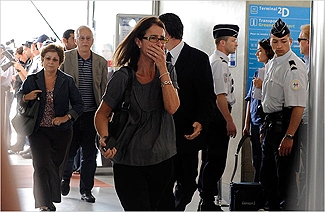"Não há esperança"
Em: 01/06/2009, às 08H49

FOTO DO THE NEW YORK TIMES
GERENTE DA COMPANHIA EM PARIS DIZ QUE "NÃO HÁ ESPERANÇA".
PARIS — An Air France passenger jet traveling from Rio de Janeiro to Paris disappeared after its electrical systems malfunctioned during a storm with heavy turbulence on Sunday evening, and officials said Monday that a search had begun for the wreckage near a small archipelago off the Brazilian coast.
Gonzalo Fuentes/Reuters
An unidentified woman arriving at the crisis center set up at Paris's Charles de Gaulle airport on Monday.
The New York Times
The plane disappeared over the Atlantic Ocean near the Brazilian island of Fernando de Noronha, Brazilian authorities said.
Readers' Comments
Share your thoughts.
Post a Comment »Read All Comments (60) »“We are very worried,” said an aviation official in Paris interviewed by Agence France-Presse. “It could be a transponder problem, but this kind of fault is very rare and the plane did not land when expected.”
The plane, an Airbus 330-200, was carrying 216 passengers and 12 crew members. The passengers were 126 men, 82 women, seven children and one infant. There were nine cabin crew members and three pilots, the airline said.
The plane took off from Galeão Airport in Rio de Janeiro at 7:30 p.m. local time, and its last verbal communication with air traffic control was at 10:33 p.m., when the pilots said they would enter Senegal air space within 50 minutes, according to a statement from the Aeronautica, the body in charge of Brazilian air space. At that time, the flight was flying normally, travelling at 520 miles per hour at 35,000 feet.
About a half-hour later, at 2 a.m. Greenwich Mean Time, the plane encountered an electrical storm with “very heavy turbulence,” an Air France spokeswoman, Brigitte Barrand, said. The last communication from the plane was 14 minutes later — an automatically sent message informing air traffic control of electrical-system malfunction, Air France officials said in Paris.
Chief Air France spokesman Francois Brousse said “it is possible” that the plane was hit by lightning, The Associated Press reported.
Officials said the plane disappeared between the islands of Fernando de Noronha, the main island of an archipelago of the same name, and Ilha do Sal, one of the Cape Verde islands.
The Brazilian Air Force sent two planes to search for wreckage, centering their initial search around the island of Fernando de Noronha, an idyllic holiday destination 186 miles northeast of the coastal Brazilian city of Natal.
“We have two planes up there searching,” Air Force spokesman Col. Henry Munhoz told O Globo television in Brazil.
All jets are built to withstand severe turbulence, especially at upper flying levels, as well as to withstand lightning strikes. Pilots are trained to try to avoid flying directly through thunderstorms, and instead try to find an opening in a storm front through which to guide their plane.
Ms. Barrand said that the pilot was very experienced, having clocked 11,000 flying hours, including 1,100 hours on Airbus 330 jets.
The head of investigation and accident prevention for Brazil’s Civil Aeronautics Agency, Douglas Ferreira Machado, told Brazil’s Globo TV that he believes the plane must have left Brazilian waters and could have been near the coast of Africa by the time contact was lost, based on the speed it was traveling.
“It’s going to take a long time to carry out this search,” he said. “It could be a long, sad story. The black box will be at the bottom of the sea,” The A.P. reported.
The plane was scheduled to arrive in Paris at 11:10 a.m. local time. It was operated by Air France and apparently did not share a flight code with Delta Air Lines, the American carrier that shares flights and routes with Air France.
President Nicolas Sarkozy of France expressed grave concern about the missing airliner and sent his transport and environment ministers to the airport to monitor the situation. He was due at the airport later Monday afternoon, and relatives of passengers began gathering in a special area set aside for them in Terminal 2.
French and Brazilian aviation authorities are expected to lead the investigation, but the United States’ National Transportation Safety Administration may be involved if the plane had American made engines or had any American passengers on board.
No Airbus 330-200 passenger flight has ever been involved in a fatal crash, according to the Aviation Safety Network, though the seven-person crew of a test flight died in a June 30, 1994, crash near Toulouse, France, where Airbus is based. The test was meant to simulate an engine failure at low speed with maximum angle of climb.
In October 2008, an A330 operated by Qantas on a flight from Singapore to Perth had to be diverted for an emergency landing near the Australian town of Exmouth after suddenly losing altitude. Dozens of passengers and crew members were injured.
Planes have been brought down by lightning strikes in the past, though it is rare. In 1988, a twin-engine turboprop FA-4 was struck by lightning in the skies over Germany, killing all 21 people aboard. In 2006, plane carrying Senator Edward M. Kennedy, Democrat of Massachusetts, across the state was struck by lightning and had to be diverted to New Haven, Conn., his spokeswoman said.
Brazil has suffered a number of fatal air crashes in recent years, and its air traffic control system, has been in crisis since 2006, when a Gol passenger jet collided with a private plane above the Amazon, killing all 154 people on board.
Ten months after that disaster, a TAM jet slid off the runway at São Paulo’s city airport and skidded across a busy highway. Some 199 people died in what became worst air crash disaster.
Although the two crashes were not directly related, Brazil’s air traffic control system and oversight of it were implicated in both. The system is run by the military, but questions were raised about the capacity, training and above all, the English-language abilities of the controllers.
Air France said that people in France seeking information about the flight could telephone 0800-800-812. For those calling from abroad, the number is 33-1-57-02-10-55.
Caroline Brothers reported from Paris and Sharon Otterman from New York. Alexei Barrionuevo contributed reporting from Buenos Aires, Micheline Maynard from New York and Brian Knowlton from Washington.












